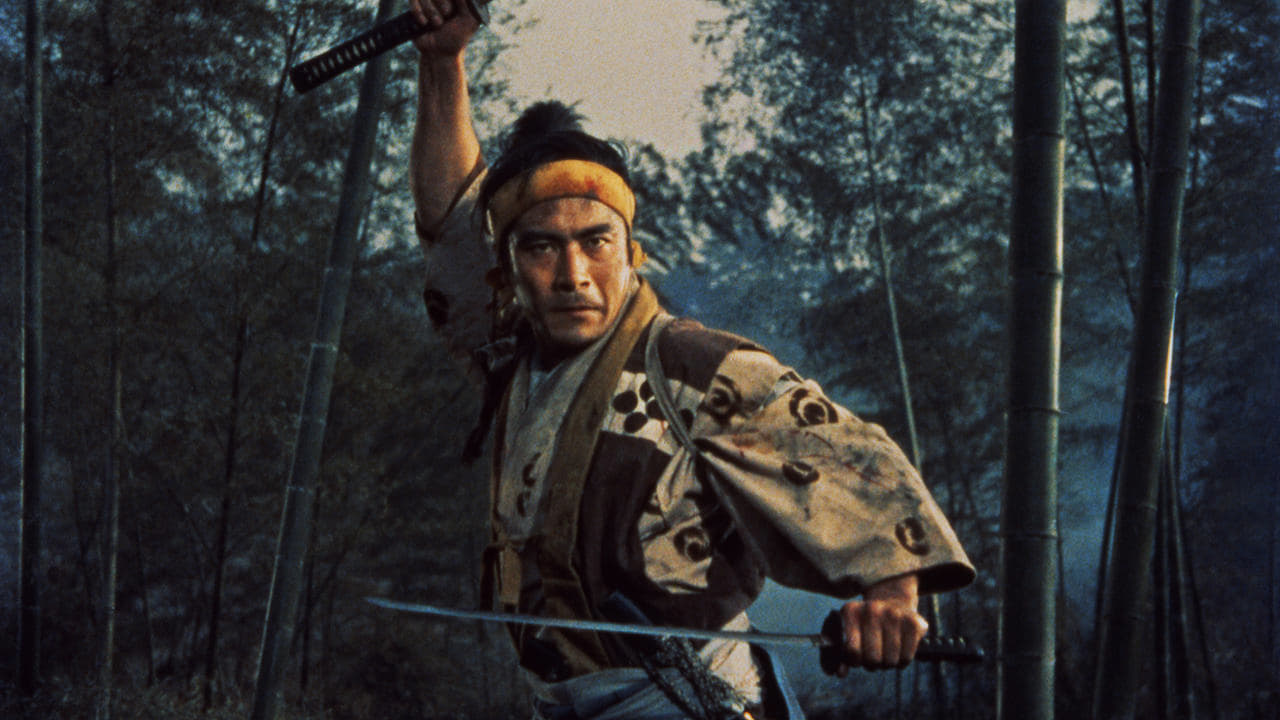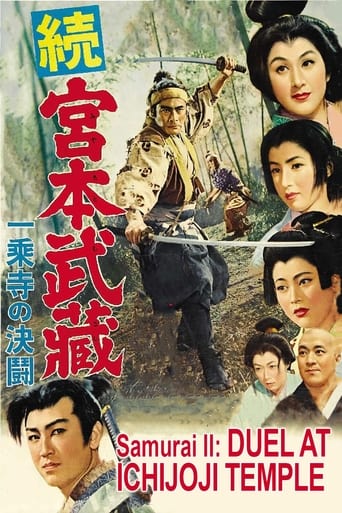Fairaher
The film makes a home in your brain and the only cure is to see it again.
Nayan Gough
A great movie, one of the best of this year. There was a bit of confusion at one point in the plot, but nothing serious.
Kayden
This is a dark and sometimes deeply uncomfortable drama
Charles Herold (cherold)
I enjoyed the first movie in the famous Samurai trilogy, but I was considerably less impressed with this middle film. The disjointedness of the first movie is even more noticeable here. There are a lot of characters and subplots and characters that don't really go anywhere. Much of the movie is laughably absurd, such as the way women fall at their feet over the rather bland protagonist (Mifune isn't nearly as memorable in these films as in his Kurosawa movies), and the determination of the students of a fighting school have in protecting their master at the expense of his reputation makes little sense, especially as Musashi keeps mowing them down.The whole looking-for-people-to-kill premise seems a bit weird as well; in American westerns it's usually the bad guys who keep picking fights. And the rather standard "there's more to being a Samurai than killing" message seems murky; it's no wonder Musashi takes so long to get it.Some of this may just be cultural, with tropes that make sense to the Japanese. But I can't see any way to excuse the use of master swordsman Sasaki. He's a really interesting character, well acted by Koji Tsuruta, but the whole movie is his just happening to be in the right place at the right time, and it's an incredibly lazy screen writing crutch.As in the previous movie, the sympathetic Otsu and women in general are treated by dirt even by those who care about them. That may be accurate, but it's also depressing.Visually the film is striking, and the combat scenes are well done and pretty entertaining, but overall this movie is poorly structured and generally absurd.
foxfirebrand
This comment about the "Samurai Trilogy" starts on the page for Miyamoto Musashi (Samurai I). My first viewing of the second episode was memorable because I got to take the train into town all by myself, and view it in a Tokyo theater. The first episode had just been shown on base, in a sort of cultural exchange, and my parents saw it and were pleasantly non-outraged-- I was a 9-year-old samurai-movie addict, and they believed enthusiasm beyond a certain intensity should be curbed. It was the same conflict as comic books some few years earlier. Technicolor was a big deal back then, especially in Japan, and it became the issue on which my viewing of "swordfighting movies" was decided-- the ones in color were historical films worth viewing, and even had something to teach. The black-and-white ones shown in Irumagawa and surrounding villages-- I had to sneak off to see. Ichijoji no Ketto (Duel at Ichijoji Temple) shows Miyamoto-san's achievements, while barring no holds on the issue of what they cost him. The romantic subplot continues, though its development in the western sense (toward union, wedded bliss) is thwarted at every turn. The issue is always a conflict between love and duty, and each deferment of gratification spells out a new step in the redefinition of the national character that is being mapped here. Again, some of the importance of all this is lost, even to modern Japanese audiences for whom the issues are long settled-- at the time, though, they were cliffhangers. A new character is introduced, Kojiro Sasaki who will emerge in part 3 as a rival for Musashi-- his equal except for certain features in their respective character. By the way, the score is excellent and haunting-- it extends like a symphony through all three parts, and has a leitmotif "hook" that will cause your ears to pick up in recognition, perhaps years from now, when you hear it again.
$kOrPiOnNeGrO
OK. First of all, I am huge Toshiro Mifune fan. I am also a huge...and I mean huge Musashi fan. And lastly I have seen plenty of Samurai films. But I have watched Samurai 2: Ichijôji no kettô twice now, and I just can't stomach it. It is perhaps one of the most clichéd samurai films I have ever seen. The story seems to be based on the mystical Miyamoto Musashi, rather than a more realistic character. In addition, there is so much thick, syrupy melodrama and love triangles that it really hinders the story from flowing well. Not to mention it often takes away energy from some of the action scenes.Mifune really makes this film bearable. Koji Tsuruta as Kojiro Sasaki is also outstanding and commands plenty of respect on screen. However, some of the other actors are mediocre at best.There is much to be said about old Samurai cinema, and the way they glorified and really elevated these noblest of warriors. But Ichijôji no kettô just covers it in a thick melodramatic goo and wraps it in toilet paper.In addition, the film has very bad lighting, plenty of anachronisms, continuity problems and poor editing. Once again, Toshiro Mifune as Miyamoto Musashi is my personal hero, Jesus Christ, Lord and Savior...but was there ever! a less fitting movie for this cinematic giant.RE-MAKE!
MartinHafer
Without the first and third movies in the trilogy, this movie would probably seem like a better flick. But considering how strong the movie began and how it finished even stronger, it is natural that there was a lull in the middle. It reminds me of the Empire Strikes Back--certainly not as exciting at the first Star Wars picture they made and not as satisfying as the conclusion because nothing was particularly resolved in the flick.This movie concerns the transformation of Mifune from a young samurai warrior to a COMPLETE samurai. In other words, he is learning that there is more to being a samurai than just being able to beat others in combat. Exactly what this ideal samurai is to be seems uncertain, however Mifune is convinced by the end of the movie that there is no room on this path for the beautiful and ever faithful Ostu. Poor Otsu! It is important to note that these movies were made nearly 50 years ago and existing copies on DVD are in poor condition--with fading and sepia tones instead of the vibrant original. This became VERY apparent when I saw the beginning of the 3rd film. The color was nearly perfect for the initial scene and that is great, as it's a beautiful and extremely artistic shot. At times throughout the movie, some of the scenes are once again vivid while others are faded and lose their impact. You can't blame the film for that, but you wish Criterion would try to digitally enhance the prints they've got to improve the colors and get rid of some scratchy cels.

